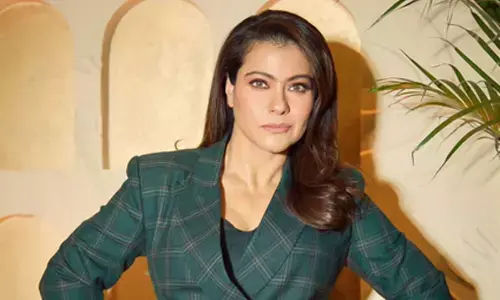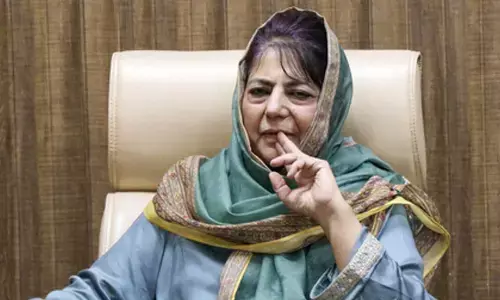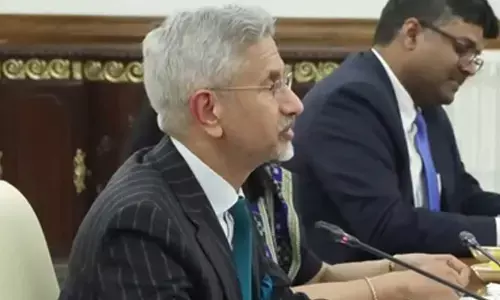Painting a new narrative

Painting a new narrative. Laxman Aelay is not just a witness to events and happenings of his time as an artist; he makes significant contribution to the history of art and cinema in this part of the world.
Laxman Aelay is not just a witness to events and happenings of his time as an artist; he makes significant contribution to the history of art and cinema in this part of the world.
Hailing from Kadirenigudem village in Nalgonda district and born to a weaver father, Laxman Aelay rose to be an artist (self-taught largely) recognised in the country too. Rooted in the rural milieu Laxman never shed off this aspect but adapted himself to modern thoughts and ways of life. His works of art have reflected this metamorphosis. From painting signboards and posters, giving up a salaried job to pursue BFA, and then evolving as an artist over the years, the wheel seems to have turned full circle with Laxman now pursuing a PhD in EFLU.
Laxman is having his solo show titled ‘Fellow Travellers’ to be held at Jehangir Art Gallery in Mumbai the preview of which is at Kalakriti Art Gallery in Hyderabad.
Belonging to the Padmashali caste Laxman was exposed to colour, texture warp, weft and design. Yet he chose to work his way up the hard way educating himself and working at the same time. “I had good handwriting and I used to write sign charts in the village,” he says humbly. This talent came in handy when he came to pursue his B Com in the Arts and Science College in the city. While studying he used to paint signboards in Ranigunj, a commercial area in Secunderabad. Later he also got a job in the Telugu daily Eenadu when he had to do cut and paste job as a layout artist for a living. Subsequently he did illustrations and graphics. However, his interest lay in art. After reading Chalasani Prasada Rao’s ‘Adhunika Chitra Kala’ and ‘Russian Chitra Kala’ Laxman was inspired. He resigned from Eenadu and joined JNTU to do BFA (which he had heard about). Simultaneously he opened his designing studio and this paved the way for creating the first digital poster and the friendship with film director, Ramgopal Varma!
Manual designing of posters was in vogue till Laxman ushered in the digital ones. He worked on films like Rangeela, Satya, Daud, Daiyyam, Money Money, Ninne Pelladutha, Gulabi etc. He brought his BFA knowledge to this digital art. “I used to get the posters printed in Pragathi Art Printers in those days. These posters were stylistic and contemporary. I was on a good wavelength with Ram Gopal Varma (RGV). He used to drive to the studio straight from the airport. I would make one logo at times and he would okay it. In fact RGV asked me to shift to Mumbai. I made a few trips to Mumbai while working for the films then.”
But Laxman chose to settle in Hyderabad for the love of art. “I got a lot of offers. In fact all the films I did posters for, were very successful and ran for 100 days and more. I did designing for survival and wanted to get into painting. So I shifted to art and had my first show “Images in Kadirenigudem” in June 1999. From then on there was no looking back for Laxman. “It was Jagdish Mittalji who recognised my talent and bought some drawings from my studio and encouraged me. Since then I have a good rapport with Mittalji.”
He has not completely distanced himself from cinema and has done art direction for a few films, with critically acclaimed ‘Lotus Pond’ being the latest.
Laxman’s career in art was on the upswing after the show. Numerous group shows, some solo shows and participation in art camps happened. Although Laxman shifted to Hyderabad from his village he was close to his roots visiting it often. “The village is just about 80 kilometres from Hyderabad.” The bucolic imagery formed part of his works. “Reading Telangana literature, association with poets, writers, feminist and activists influenced me and got into the sub-conscious. I also used to design book jackets for some of the writers.”
Again it is because of Mittalji that Laxman had a look at the Nakashi scrolls which delineate the caste puranas in the Jagdish and Kamla Mittal Museum. “I would not have seen the scrolls but for Mittalji. He has a scroll dating back to 1825. The images are so entrenched in my mind that even in my sleep they pop up.” This has enthused him to study the Nakashi Painting and Dalit Bahujan performance (a tentative title of his thesis) art forms for his doctoral dissertation.
Laxman’s works have been largely figurative. In his latest works one can see the influence of popular culture besides the folk narrative tradition (Nakashi scrolls) leather puppets and contemporary social issues. I live in contemporary world. I accept modernity and look at the past and the present as well.” So his paintings which are grounded in the rural and folk narrative traditions depict the urban clutter, chaos and modern symbols like the mobile phone.
On his latest exhibition Professor Susie Tharu says: “The frames in this new set of Laxman Aelay’s paintings are also abuzz with conversations about art languages, the meaning of images and the worlds in which an image circulates and finds life......”
Laxman eschews the painted backdrop or realist props used in the ethnographic records and draws on the extraordinarily rich art practices and traditions of this region to elaborate a setting for his figures in these expressions. In effect he lifts these ethnographically formed figures out of one art world and its historical accretions, and places them in another. The new world is a lively and sometimes unruly one, contemporary, actively in formation and using a genre-bending mix of picture, story and song. In these backdrops there are citations from caste puranas recounted in the Nakashi scrolls, the leather shadow puppets used by the tholubommalata troupes, the paitani weavers around Aurangabad and kalamkari fabric artists. The marginalised musical traditions of the nomadic tribes and their instruments are another theme. Modern Telangana is not overlooked...”

















